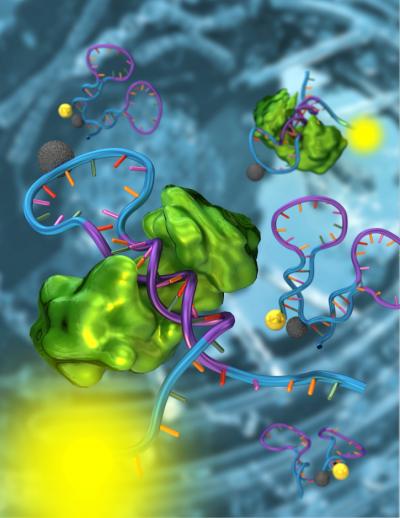Nanosensors made from DNA may lead to new cancer tests and drugs
September 9, 2011

A structure-switching nanosensor made from DNA (blue and purple) detects a specific transcription factor (green) (credit: Peter Allen)
Nanosensors made from custom DNA molecules that could be used to personalize cancer treatments and monitor the quality of stem cells have been developed by an international team of researchers led by scientists at UC Santa Barbara and the University of Rome Tor Vergata.
The new nanosensors can quickly detect a broad class of proteins called transcription factors, which serve as the master control switches of life.
Using these nanosensors, a team of researchers from UCSB has demonstrated the detection of transcription factors directly in cellular extracts. The researchers believe that their strategies will allow biologists to monitor the activity of thousands of transcription factors, leading to a better understanding of the mechanisms underlying cell division and development
“The fate of our cells is controlled by thousands of different proteins, called transcription factors,” said Alexis Vallée-Bélisle, a postdoctoral researcher in UCSB’s Department of Chemistry and Biochemistry, who led the study.
“The role of these proteins is to read the genome and translate it into instructions for the synthesis of the various molecules that compose and control the cell. Transcription factors act a little bit like the ‘settings’ of our cells, just like the settings on our phones or computers. What our sensors do is read those settings.”
When scientists take stem cells and turn them into specialized cells, they do so by changing the levels of a few transcription factors, he explained. This process is called cell reprogramming. “Our sensors monitor transcription factor activities, and could be used to make sure that stem cells have been properly reprogrammed,” said Vallée-Bélisle. “They could also be used to determine which transcription factors are activated or repressed in a patient’s cancer cells, thus enabling physicians to use the right combination of drugs for each patient.”
Ref.: Alexis Vallée-Bélisle, Andrew J. Bonham, Norbert O. Reich, Francesco Ricci, Kevin W. Plaxco. Transcription Factor Beacons for the Quantitative Detection of DNA Binding Activity, Journal of the American Chemical Society, 2011 [DOI: 10.1021/ja204775k]